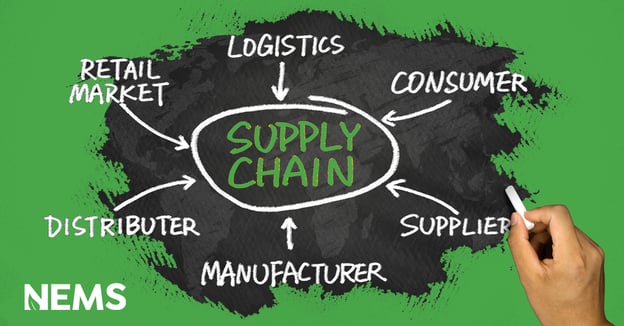Chapter 2 -
Defining business goals and the organizational boundary for a Scope 3 inventory
Author: ÖzlemYetkinoglu Sobhi

How do we start addressing Scope 3 emissions? The very first thing to do is to define business goals or the motivation behind preparing a Scope 3 inventory. What are the intentions behind preparing such a thorough GHG emissions inventory, which can be expensive and very time demanding at times. Intentions can be several…
Setting your business goals
Is it to gain company reputation and eventually respond to the demands and expectations of stakeholders, customers as well as employees who are increasingly becoming more and more environmentally conscious?
Is it a procuration against possible risks associated with value chain emissions? To gain a good understanding of these risks and stay alert and prepared.
Is the company aiming to establish good and thorough GHG reporting regimes to set reduction targets and track performance over time, to identify hot spots and areas where emission reduction is feasible and possible and eventually reduce emissions?
Or is the goal to shed light on value chain partners to understand the supplier operations better, and eventually partner with the companies and other actors in the value chain to reduce emissions and gain financial benefits via energy and material savings?
The goals may be many, and the Scope 3 standard requires a clear definition of business goals before starting the calculations. Whys is it important to define business goals first? This will first of all ensure that resources are allocated effectively and thus objectives can be met more efficiently. It will also ensure that the company’s overall business strategy associated with sustainability is taken into consideration and that they are accounted for.
The value of addressing a Scope 3 inventory is big and unlocks various opportunities. Scope 3 should not be used or viewed as a corporate reporting tool only. Defining business goals will also give the company the opportunity to assess and understand the true value of a Scope 3 inventory. It will aid companies to lead them to the desired sustainability direction. Understanding the risks in the value chain is crucial to survival for business. Studies suggest that companies usually do not have any overview of the Tier 2 and higher suppliers in their supply chain. A Scope 3 inventory results in building and increasing awareness of operations in the value chain and lays down risks and opportunities. This knowledge should be used to manage these risks and advantages by uncovering possible future scenarios as planet earth has limited resources.
Once the business goals are defined, The Scope 3 standard requires that reporting principles are reviewed and that companies balance between principles depending on their already defined business goals. The following five principles are to be followed: relevance, completeness, consistency, transparency, and accuracy.
Identify your activities and define your boundary
Next step is to identify relevant Scope 3 activities and define the Scope 3 boundary. GHG Protocol defines emissions as direct and indirect emissions and divides them into 3 scopes. Direct emissions are emissions generated from sources that company own or control and are included in Scope 1. Indirect emissions are emissions generated from sources that the company does not own or control and are included in Scope 2 and Scope 3. It is important to note that these three categories are mutually exclusive for a company and are defined to avoid double counting. Scope 2 emissions is solely about emissions from the generation of purchased energy. Scope 3 emissions cover all emissions in the value chain which are not included in Scope 1 and Scope 2 and it is split to 15 categories. The standard defines the first 8 categories as upstream emissions and the last 7 as downstream emissions.
Before going into definitions, reporting requirements and other details about the Scope 3 categories we should first investigate how the boundary of a Scope 1. Scope 2 and Scope 3 inventory is defined.
Firstly, the organizational boundary which includes three approaches; equity share, financial control and operational control should be decided. This decision is to be consistent across Scope 1, Scope 2 and Scope 3 inventories. These three approaches originate from financial accounting and the GHG Protocol standards attempts to unify financial accounting and carbon accounting terms as it expects that GHG emissions may be treated as liabilities and emission allowances in future.
But what do we mean by organizational boundary? Companies have different financial and legal structures such as joint ventures, subsidiaries, wholly owned operations etc. and sometimes some other complex business relationships. Organizational boundary is the highest-level boundary and defines which business entities and assets (such as facilities) will be included in the inventory. If the company fully owns its operations, then the organizational boundary will be the same whichever approach is used. But for companies with joint ventures and complex structures like oil companies where both operated and non-operated assets are partially owned the chosen approach will result in different organizational boundaries and emissions. The principle is that the chosen organizational boundary should capture the majority of the operations. The organizational boundary also affects which emission sources will be defined as direct and indirect emissions.

Organizational boundary should not be mixed with operational boundary which draws the line for which emission generating sources such as power generation unit, buildings, car and ship fleet that will be included. Organizational boundary is the highest-level boundary and operational boundary is decided after the organizational boundary is set.
Equity share approach requires to report emissions from sources that are financially owned by the company and the size should be limited to the percentage share of equity in the entity.
Operational control on the other hand requires 100% emissions reporting from emissions sources that the company has operational control.
Example 1: Company X is an oil company and has 30% equity share in offshore oil field A but it has no operational control over the field, it has also 40% equity share in oil filed B with operational control.
- If the company selects equity share approach
- 30% of emissions from oil field A should be included in its Scope 1 inventory
- 40% of emissions from oil field B should be included in its Scope 1 inventory as well
- Emissions in the value chain of oil fields A and B should be included in its Scope 3 inventory
- If the company selects operational control approach
- 30% of emissions from the oil field A should instead be included in its Scope 3 inventory as an investment (Category 15)
- 100% of emissions from oil field B should be included in its Scope 1 inventory
- Emissions in the value chain of oil field A should not be accounted for in its Scope 3 inventory. However, emissions in the value chain of oil field B should be included in its Scope 3 inventory.
Example 2: Company Z is a company which has leased some vehicles such as cars, it is an operating lease meaning Company Z has no ownership of the car but it operates the car
- If Company Z selects equity share approach
- No emissions associated with fuel combustion (i.e diesel cars) and use of purchased electricity (i.e electric cars) should not be included in its Scope 1 inventory. These emission should be included in its Scope 3 inventory as Upstream leased assets (Category 8)
- If Company Z selects operational control approach
- 100 % emissions associated with fuel combustion (i.e diesel cars) and use of purchased electricity (i.e electric cars) should be included in its Scope 1 and Scope inventories respectively.
The third approach, financial control is not as widely used as the equity share and operational control approaches. This approach requires 100% GHG reporting from entities the company has financial control.
In our next issue we will focus on operational boundaries and Scope 3 categories. In other words, we will describe Scope 3 activities and discuss how to decide on which Scope 3 activities to include in the inventory.
